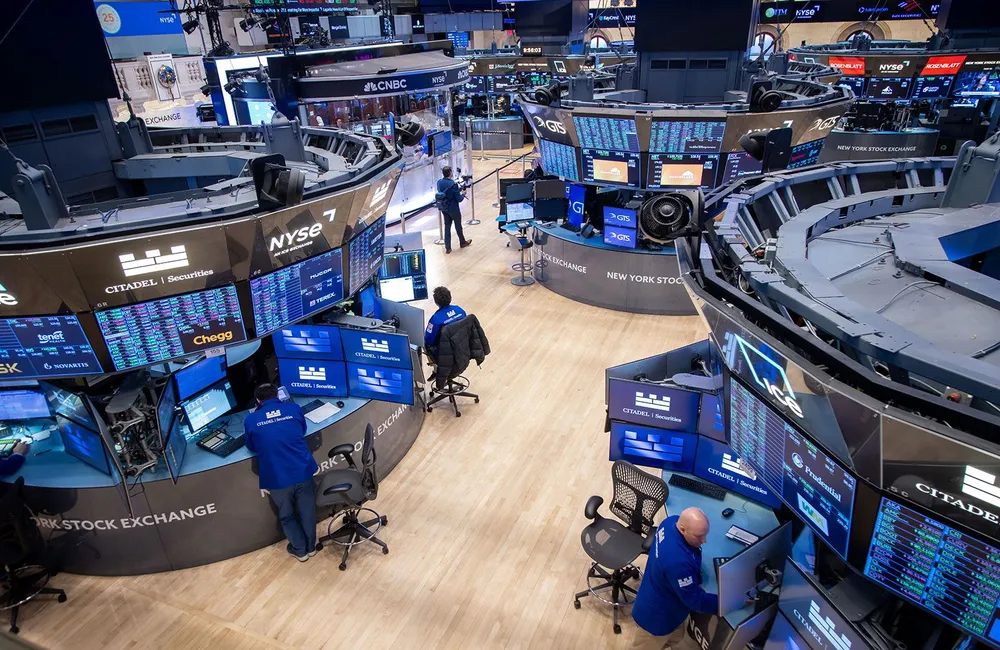ASX futures rose 33 points, or 0.4 per cent, to 7413 at 8.00 AEST, indicating a strong start to the day.
Major indexes moved lower for much of the session before rising late in the day and closing mixed. The S&P 500 gained 0.5%, and the Dow industrials climbed 0.4%. The Nasdaq dropped 0.2%. For the week, the S&P 500 rose 1.8 percent, bringing its gains over the past two weeks to 8.1 percent, its strongest stretch since late 2020. The technology-focused Nasdaq Composite climbed 2 percent and has now risen more than 10 percent in two weeks. The Dow Jones Industrial Average was up 0.3 percent for the week.
Stocks are on a tear because of optimism over the resilience of the U.S. economy and its capacity to power through higher interest rates and the fallout from the war in Ukraine. The Nasdaq Composite has added 9.4% since US Federal Reserve chairman Jerome Powell asserted during a press conference on 16 March following the bank’s raising of interest rates for the first time since 2018 that the US economy and labour market remain strong.
“Any sort of additional rally from here potentially has the potential to be self-correcting, because it could tempt the possibility of more and larger rate hikes,” said Doug Ramsey, chief investment officer at the Leuthold Group.
Elevated rates have sped up a historic selloff in bond markets that has pushed yields to heights not visited since early 2019. Interest-rate sensitive short-term debt has been most hard hit. The spike in yields may have helped dull the appetite for technology stocks on Friday.
Locally S&P/ASX 200 finished 0.3% higher at 7406.2 as ongoing strength from commodity stocks brought the benchmark index its fourth-straight gain. The ASX 200 closed up 1.5% on the week.
This was after a strong lead from US equities as Australian materials stocks followed in the footsteps of their US peers. The sector, the second largest in the index by market capitalization, gained 1.3% as iron-ore and gold miners advanced.
Building-products maker Brickworks gained 4.8% after a mostly bullish reaction to its 1H results from analysts.
Energy explorers Santos, Woodside and Beach rose between 0.6% and 1.2%, but the heavyweight financial sector fell 0.5% on weakness from banks ANZ, NAB, Westpac and Commonwealth. Westpac said Australian consumers were continuing to spend strongly as the economy attempted to pull clear of the pandemic. The Westpac Card Tracker Index, which tracks electronic card transactions, rose by 6.7 points to a record 113.3 in the week to March 19.
Iron ore was up by 3 per cent to US$150.80 per tonne in commodity markets; Brent Crude gained 1.4 per cent to US$120.65; gold futures edged down 0.4 per cent to $1959.80.
Bond rout continued Friday, with the US 10-Year Treasury Note yield popping up to 2.47%, the worst in years. The yield on Australian 10-year bonds was higher at 2.77%. Yields rise when prices fall.
The Australian dollar ended the week at a five-month high, buying 75.14 US cents as of Saturday morning, up from 75.12 US cents at the previous close. The WSJ Dollar Index, which measures the US dollar against 16 other currencies, eased to 91.43.
Asia
Chinese stocks declined, as Asian equities were broadly lower. The Shanghai Composite Index fell 1.2 percent and the Shenzhen Composite Index declined 1.4 percent. The ChiNext Price Index, heavy in tech, was the biggest laggard among the most important indices, falling 2.5%. The downturn was led by drug makers and medical services providers, as the sector pulled back from recent soaring gains fueled by optimism over the licensing of Covid-19 oral treatments under development. Consumer goods companies added pressure on the market, continuing to be wary of China’s current pandemic outbreak.
Hong Kong shares ended lower, tracking losses in other regional shares. The benchmark Hang Seng Index fell 2.5%. The tech sector, which continued to show signs of weakening from a recent, sharp snapback rally sparked by Beijing’s vows to support the sector, was also the biggest drag on the market. The Hang Seng TECH Index lost 5.0%. Alibaba Health fell 9.2%, while Meituan dropped 8.2% before earnings due this evening. Consumer stocks piled on the pressure, with Haidilao plummeting 7.7% and Li Ning losing 5.6%.
The Nikkei Stock Average closed 0.1% up as gains in chemical and pharmaceutical stocks carried the market, though banks and insurers struggled. Mitsubishi Chemical Holdings advanced 2.6% and Nippon Paint Holdings added 2.5% after some of the declines in crude oil prices relieved fears over escalating raw material costs. Investors continue to pay close attention to the war in Ukraine and its effect on commodity prices.
Europe
European stocks finished mostly higher but the gains were modest as investors remain skittish over the Russia-Ukraine conflict.
“It looks like we’ve reached a stage in which the initial shock of the Ukraine invasion has faded and markets corrected back down to a level where the economic risks are considered priced in,” Oanda analyst Craig Erlam says. The pan-European Stoxx Europe 600 gained 0.1 percent on Friday and broke a two-week streak of gains to finish the week slightly lower, down 0.2 percent.
Wall Street ended the week with gains on Friday, which followed a day earlier when shares in oil and mining companies continued to rise and induced the UK index to close 0.2% up in London. Shares of Shell climbed 1.4% and BP advanced 0.6%. So did commodity majors Glencore, Anglo American and Rio Tinto. On the other hand, copper producer Antofagasta fell 2.6% as the stock was cut to sell by UBS, which cautioned over a potential blow from increased taxes in Chile and little potential for copper price upside.
Russian stocks fell 3.7% after the Moscow stock exchange partly reopened from a month-long shutdown, unwinding some of Wednesday’s 4.4% spike. Shares in Gazprom fell 12% and Russia’s biggest lender Sberbank lost 3.5%.
North America
US stocks rose for a second straight week as investors held confidence that the economy can bear higher pain from the escalating war in Ukraine and the Federal Reserve’s program to hike interest rates to curb inflation.
The S&P 500 rose 1.8 percent for the week, adding to its gains over the previous two weeks of 8.1 percent, the biggest streak since late 2020. The tech-heavy Nasdaq Composite climbed 2 percent, adding to its more than 10 percent two-week gain. The Dow Jones Industrial Average rose 0.3% on the week.
A renewed surge in bond yields still tempered some of the stock market’s enthusiasm Friday.
They spent much of the session trading lower before gaining late in the day and closing mixed. The S&P 500 gained 0.5%, and the Dow industrials climbed 0.4%. The Nasdaq dropped 0.2.
Forecasters have been calling for the Federal Reserve to raise interest rates more aggressively than it expects to in order to tame inflation that remains at a multi-decade high. Economists at banks including Citigroup and Bank of America have this week put the possibility of a half-percentage-point lift back on the table, as the central bank has moved into a new phase of its rate-setting campaign one that it recently elected to end with this month’s quarter-point increase.
These kinds of forecasts have shaken the government bond market. The yield on the 10-year Treasury note, the benchmark for most consumer and corporate debt, rose to 2.491% from 2.340% on Thursday, the highest since May 2019.
On signs that investors were adjusting up their expectations for interest rates, the yields on shorter- and medium-term Treasurys the ones most influenced by Fed policy were rising more than longer-term bonds. The yield on the three-year note rose to 2.536% from 2.346% on Thursday. The five- and seven-year notes yielded more than 2.5 percent when they closed, as investors priced in increasing expectations that the Fed might even lift rates to 3 percent next year, only to bring them down later.
For that reason, the recent rebound in the stock market, which suggests that investors are taking rate increases in stride, could embolden the Fed to take a more aggressive line in lifting rates, some investors say.
“Any rally from here could be self-correcting because it would bring the possibility of even bigger, and more, rate hikes,” said Doug Ramsey, chief investment officer at Leuthold Group.
The war, meanwhile, has stoked worries about inflation and upended commodity supplies. President Biden warned that the United States would respond if Russia used chemical weapons and urged for that country to be expelled from the Group of 20 industrial and developing nations, amplifying fears of further escalation.
“Markets are attempting to price in something that is essentially unpriceable,” given that much of what’s happening in the world relies on Putin’s thinking, which no one knows, said Fahad Kamal, chief investment officer at Kleinwort Hambros. “The longer the conflict continues, the greater the upside to inflation and the less downside to growth. It’s totally, radically uncertain.”
But firms that are more domestically oriented may be insulated from the worst of the war-induced turbulence. Many of those companies are still turning in solid profit outlooks, said Diane Jaffee, a senior portfolio manager at TCW.
“There has been some degradation in earnings outlooks, but the revisions have been very mild so far,” she said.
Regional banks were among the biggest gainers Friday. Comerica rose $3, or 3.2 percent, to $97.04 and Zions Bancorp also gained $2.50, or 3.6 percent, to $71.08. Energy companies also gained, with Coterra Energy up $1.88, or 7 percent, to $28.91.
Consumer confidence for March fell short of what economists expected, a University of Michigan survey released Friday showed. The gauge has been sagging lately as consumers, especially lower-income households, have dimmer assessments for the economy.





















